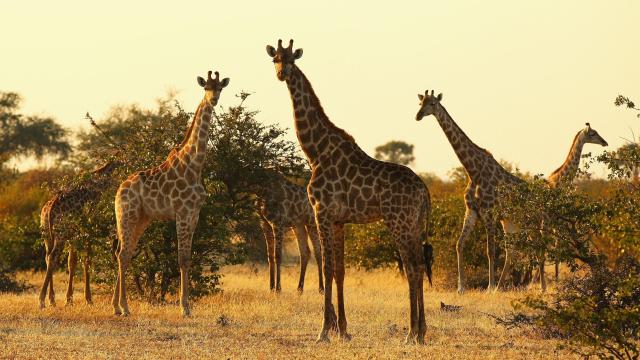Giraffes are way more socially competent than we give them credit for, a team of scientists from the University of Bristol say. They’re calling for an updated understanding of the incredibly tall artiodactyls.
Giraffes have the unfortunate circumstance of sharing the African savanna with elephants, the largest land mammals on Earth and renowned for their intelligence and social skills. But the new research, published yesterday in Mammal Review, is the latest look at giraffe social structure, which has received new interest in the last decade. Before then, biologists didn’t think the mammals had much of a social structure at all, according to the new paper.
“It is baffling to me that such a large, iconic and charismatic African species has been understudied for so long. This paper collates all the evidence to suggest that giraffes are actually a highly complex social species, with intricate and high-functioning social systems, potentially comparable to elephants, cetaceans and chimpanzees,” said Zoe Muller, a biologist at the University of Bristol and the study’s lead author, in a university press release.
Muller’s team reviewed 404 previous papers on giraffe behaviour to get a broad view of the animals’ social system, paying special attention to females in different social groups, male giraffe dispersal, and how offspring are reared and for how long. They found giraffe social structure to be on par with those of other intelligent mammal species that form cohesive social groups. Some of those groups — namely orcas — have a matriarchal social hierarchy, meaning that the oldest females run the show.
The research team estimated that giraffes spend nearly a third of their lives in a post-reproductive state, with females of the species living beyond menopause to aid in raising new generations of offspring. Since giraffe herds can range from about half a dozen of the animals to nearly 50, that’s no small task. This phenomenon — the so-called grandmother hypothesis — is seen in some whales, primates, elephants, and now giraffes. In effect, the elder animals are biologically configured to ensure the longevity of their social group by sticking around a little longer. The giraffes in these studies spent up to 30% of their lives in that post-reproductive period, compared to 23% for elephants and 35% for orcas.

“Recognising that giraffes have a complex cooperative social system and live in matrilineal societies will further our understanding of their behavioural ecology and conservation needs … If we view giraffes as a highly socially complex species, this also raises their ‘status’ towards being a more complex and intelligent mammal that is increasingly worthy of protection,” Muller said.
Giraffes can stand at nearly 6.10 m tall, have purple tongues, and have tufted bony structures on their heads called ossicones that look like something out of a Dr. Seuss book. Frankly, I didn’t need more convincing they’re worth protecting, but hopefully the new findings pull more folks across that line.
